Take a guided walk around a cream coloured slice of Hull history
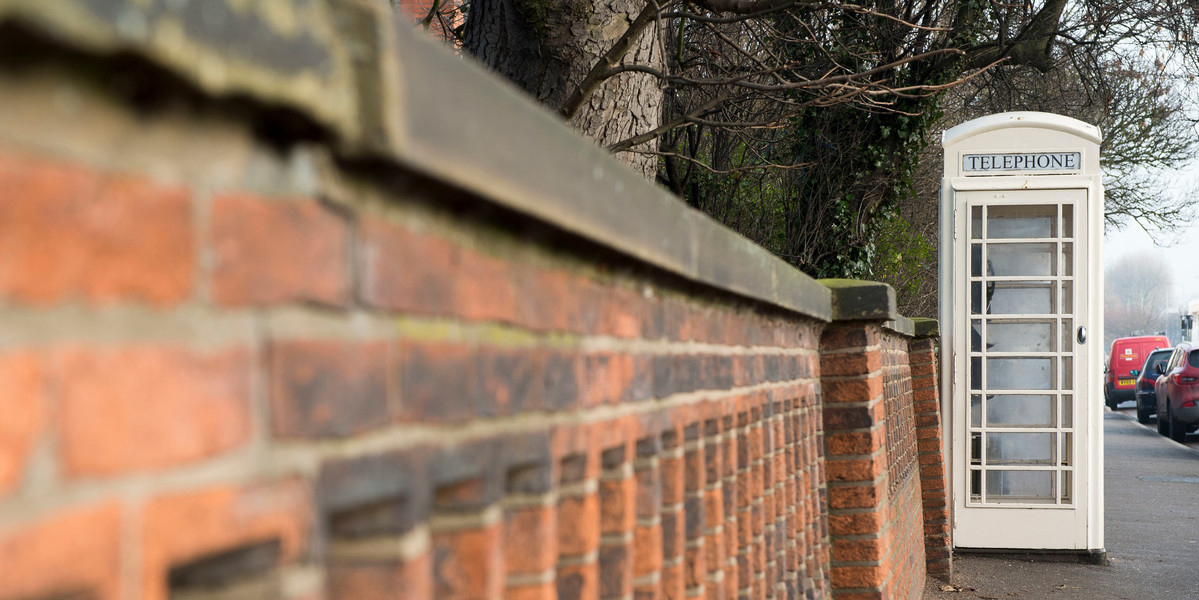
From the ancient walls which once dared to deny a king - to the city’s many magnificent Victorian buildings, a wander around Hull means stepping back into an era of fascinating history and rich heritage.
And of all the images that instantly conjure up Hull, surely the cream K6 telephone box is one of the most iconic.
Designed by Sir Giles Gilbert Scott to commemorate the Silver Jubilee of the George V the K6 has come to symbolise the very essence of Britishness.
But while the rest of the country is famed for its red phone boxes Hull steadfastly remained independent and kept its own phone cream phone boxes run by its own independent phone company, which has now become KCOM.
We took a walk around these elegant design classics not only gives an insight into Hull’s uniqueness but also a chance to marvel at some of the city’s historic highlights.
This trail around 12 of our phone boxes should take you about 90 mins, with plenty of opportunities to stop for a drink or bite along the way. Plus it’s ideal for youngsters who want to learn a little more about Hull’s colourful past.
Check in each of the kiosks on the route for a letter, collect all 12 and you should be able to rearrange them to spell the name of someone closely related to the phone boxes.
To view a map of the KCOM phone box trail, please click here.
Phone box 1
Our walk begins in the splendid surroundings of Hull’s revamped Trinity Market. To find our first phone box wander through the grand Edwardian food hall and into the market stall area and you’ll find our first stop there. Introduced in 1921, this Grade II listed phone box – one of only five in existence – is a hybrid of two K1 designs; the MK234 and the MK236, which was introduced in 1927.
If you have time, wander outside into the beautifully ornate Victorian Hepworth Arcade to peruse the quirky independent galleries and shops. The arcade dates from 1894 and was where a certain Mr Marks and Mrs Spencer opened up one of their very first penny bazaars in 1899. Dinsdale’s famous joke and trick emporium in the arcade is said to be the favourite shop of Hull’s Reece Shearsmith, of the League of Gentlemen fame.
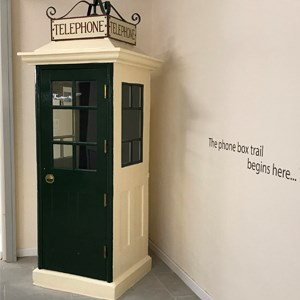
Phone box 2
From the arcade’s Silver Street entrance take a left and then turn down the wonderfully-named Land Of Green Ginger. Pause only to admire the apartments on the right with the memorable, Peter Pan-inspired address Second Star on the Right and Straight on ‘til Morning, and then down Bowlalley Lane, which was once home to a 16th Century bowling alley.
Turn left at the bottom onto Market Place and you’ll find your first K6. Actually you’ll find two, a pair of telephonic K6 twins. These kiosks enjoy Grade II listed status and are located right outside the old Post Office, dating from the early 1900s. Across the road you’ll spy St Mary’s, which competes with Hull Minster for the title of Hull’s oldest church.
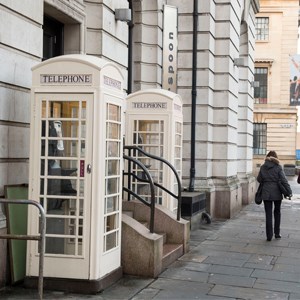
Phone box 3
Head a few steps around the corner into Alfred Gelder Street to find kiosk number three. Look up on the wall for a blue plaque commemorating this as the site of Suffolk Palace, the old ancestral home of the De La Pole family. Henry VIII stayed here on a visit to Hull in 1540 AD, when he probably went bowling around the corner.
Across the road you’ll see the magnificent Guildhall, designed by Sir Edwin Cooper which dates from 1916 at a time when Hull was a thriving imperial city and the third biggest port in the UK.
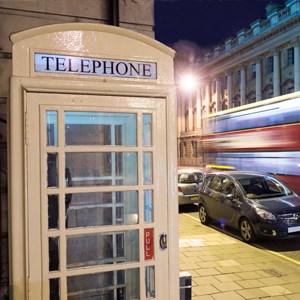
Phone box 4
Take a right down Quay Street, past the statue of Sir Leo Schultz, and you’ll find Queen's Gardens. These gardens were once Hull’s first dock, and the biggest in the country, which was renamed Queens Dock after Queen Victoria and Prince Albert sailed into the city via this route.
If you fancy a detour have a wander across the Mick Ronson memorial café at the other side of the garden and take a look at the plaque commemorating Robinson Crusoe’s literary voyage which, according to Daniel Defoe, started in Hull.
Carry along Guildhall Road to the Rose Bowl outside Queens Gardens to find our next cream K6 box. This one’s located next to the newly restored ruins of Beverley Gate where Sir John Hotham refused entry to King Charles I in 1642, thus prompting the English Civil War.
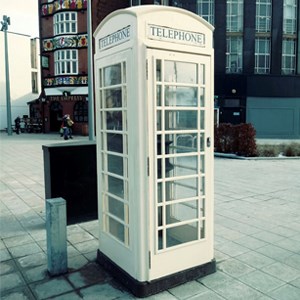
Phone box 5
To find number five, head over Monument Bridge and across Queen Victoria Square ¬- taking in the opulence of The Ferens Arts Gallery, Hull City Hall and The Maritime Museum - the former Hull Dock Offices - as you go. Points of interest here include the building next to the Princes Quay Shopping Centre which used to be the location of the tailor’s shop run by actor Maureen Lipman’s father Maurice and the ornate building which used to be the Yorkshire Penny Bank and is now home to Caffé Nero.
The next kiosk is halfway up King Edward Street at the junction of Jameson Street. Remember to check for a letter.
Here you can’t really miss the monolithic mosaic that fronts the old BHS building. This sky scraping mural was created by sculptor Alan Boyson in the 1960s and is made up of one million tiny glass cubes. It depicts three ships and, if you look carefully, you can see the word Hull spelt out in their masts.
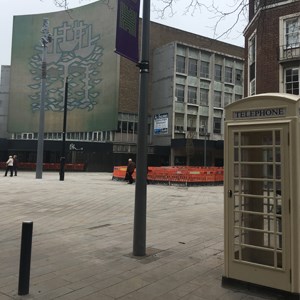
Phone box 6
Continue now up King Edward Street and Prospect Street and you’ll find our next stopping point, a modern kiosk near the statue of Hull’s most famous daughter, Amy Johnson. The pioneering aviatrix was the first female pilot to fly alone from Britain to Australia in 1930 in her de Havilland Gipsy Moth biplane Jason.
The Prospect Centre behind Amy is built on the site of Hull’s old infirmary and, if you stand with your back to the centre, looking across the street to the Central Library, you’ll notice a grand Victorian sandstone house with classical columns next to it. This was once the home to Dr James Alderson the principal physician to none other than Queen Victoria.
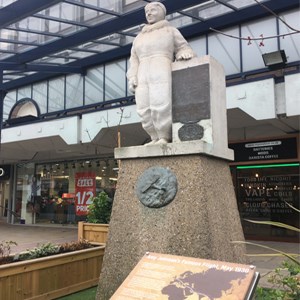
Phone box 7
The next section involves a walk down Brook Street, across the crossing to St Stephen’s Shopping Centre and down Ferensway to Paragon Station.
Outside the station you’ll find a modern KX200 phone booth – not as elegantly stylish as the K6 but it does the job. While at the William Bell-designed station take the chance to explore inside where you’ll find a bronze statue of poet Philip Larkin. The statue portrays the poet in motion rushing for a train. It’s based on the opening line of his famous poem The Whitsun Weddings in which he wrote “I was late getting away”.
Also in the station check out the plaque near the iron barriers leading to the platforms. This commemorate the 2.2m people European emigres who passed that point on the way to a better life in the USA, Canada and South Africa between 1850 and 1914.
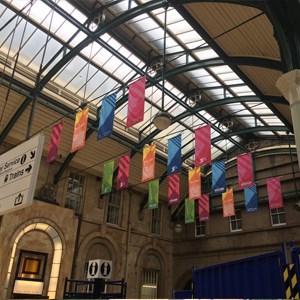
Phone box 8
For phone box number eight we need to leave the station and head back across Ferensway to Jameson Street. Incidentally, Ferensway was originally going to be called Quality Street until Hull’s great benefactor Sir Thomas Ferens died in 1930 and it was named in his honour.
Head past the Cenotaph war memorial.
Here, outside House of Fraser, you’ll find a recently reinstalled K6 kiosk at the end of this busy shopping thoroughfare that has been revamped as part of Hull’s major £25m urban renewal programme.
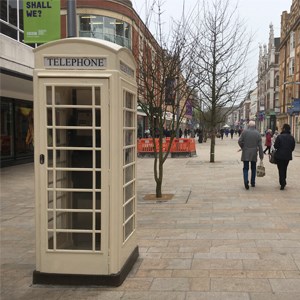
Phone box 9
Kiosk number nine is one of a pair of K6 twins, which are located outside KCOM’s HQ on Carr Lane. One of these boxes was previously painted in black and yellow stripes in honour of Hull’s own charity fundraising legend Jean “Bee Lady” Bishop but has now been returned it its classic cream livery. Jean’s phone box has been relocated outside the Integrated Care Centre named after Jean, in east Hull. Check both kiosks for letters.
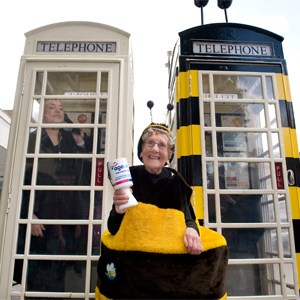
Phone box 10
For kiosk number ten head along Carr Lane and nip around the back of City Hall up Chariot Street and on to Paragon Street. Take a few moments to admire the frescos running along the top of City Hall namechecking 25 great artists including Rembrandt, Hogarth and Holbein.
You’ll pass the Hull Cheese pub which, believe it or not, is named after a pungent 17th century Hull ale which was drunk in Parliament and even mentioned by Samuel Pepys in his famous diaries.
Kiosk ten can be found under the willow trees, outside the attractive 1950s-built Queens House. This relatively new city centre addition was built on the site of the old magnificent Hull Prudential building, which was destroyed in the Hull Blitz of 1941.
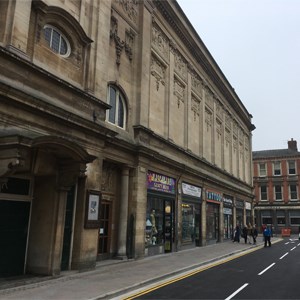
Phone box 11
It’s a bit of a walk to Kiosk number 11. Walk across Queen Victoria Square and past the restored Beverley Gate, on Monument Bridge, and then take a right down Princes Dock Street. Here on the left you’ll see the entrance to the new Zebedee’s Yard space, which was once part of Trinity House School and is now a live music and culture venue. It is named after Zebedee Scaping who was the school’s longest serving headmaster between 1833 and 1909.
Also, look out on the path running alongside the old quayside for a line marking out he old city walls and one of its old gatehouses at Posterngate. Postern being an old English word for gate, and gate being an old Viking word for street, so effectively Posterngate is Gate Street. Take care crossing the always-busy Castle Street and head along Humber Dock Street.
The newly-revitalised Humber Street, halfway down, in the Old Town’s own Fruit Market is where the actual Humber used to flow before the land that now makes up the Pier was reclaimed.
The newly-revitalised Humber Street, halfway down, in the Old Town’s own Fruit Market is where the actual Humber used to flow before the land that now makes up the Pier was reclaimed.
Head to the waterfront and you’ll find the excellent Minerva Pub, on Nelson Street, which is home to the smallest pub room in England and once served as a brig for drunken sailors.
You’ll find K6 number 11 behind the award-winning WCs on Nelson Street. Once here look to the building to the right of Cerutti’s restaurant and you’ll see the old booking office for the old Humber Ferries, which bizarrely was run by British Rail. A plaque on the wall here reveals that the first ferry set sail across the yawning estuary in 1315 AD.
It’s worth taking a few minutes to explore this scenic part of the Marina. There’s a café selling ice cream to sample while enjoying the spectacular views out over The Deep to the east and Humber Bridge to the west.
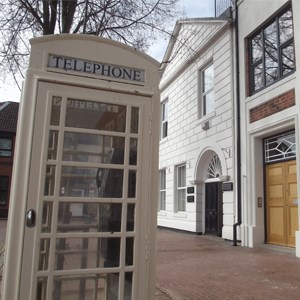
Phone box 12
For our last phone box we’re heading back into Old Town. Wander up Pier Street, by the Minerva, across Wellington Street and take a right down Humber Street until you get to Queen Street. Turn left here and head back up to Castle Street where you can use the pedestrian crossing to reach Market Place.
At the start of Market Place you’ll find the golden statue of King Billy – or King William III to give him his proper regal title. William of Orange, as he was also known, is depicted sitting astride his horse in classical attire and his statue is placed conveniently over some more public conveniences.
These loos even featured on an episode of 80s music show The Tube when Jools Holland paid a visit to explore the urban legend that goldfish swam in the cisterns.
Our final phone box can be found further along Market Place and continues with the golden theme – this time with an Olympic twist. This K6 has been painted gold to mark Hull boxer Luke Campbell’s medal triumph at the London 2012 Olympics.
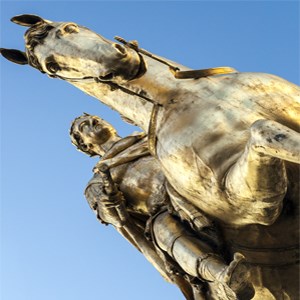
And that’s it for our phone box fun today. You’re now back in Old Town and on Hull Minster’s doorstep. Take some time to explore the newly revamped Trinity Square and the rest of Hull’s treasure trove of history.
We hope you enjoyed your trek around some of the city’s wonderful history, as seen through our iconic cream K6 phone boxes.
With thanks to legendary Hull tour guide Paul Schofield. For more information about Paul and his tours of historic Hull visit www.tourhull.com.
